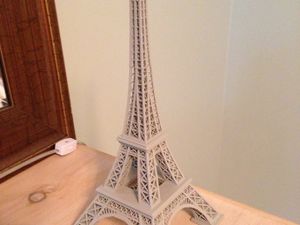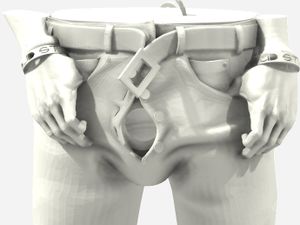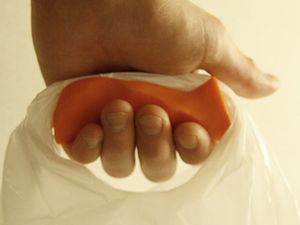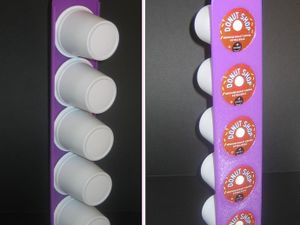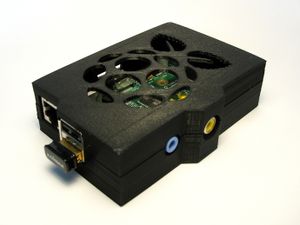User:Scottmilander
Contents
Introduction
My name is Scott Milander and I am a super senior at The Pennsylvania State University. I am majoring in Civil Engineering with a specialization in Geotechnical Materials. I work full-time for Penn State at the Larson Transportation Institute in the Pavements Lab as a Lab Technician, while taking classes part-time to finish my degree.
Penn State has a 3D Print Service called Printrverse that can be found here. Anyone in an Desgin course can submit their .STL file to be printed during the semester.
Projects
During this Fall 2013 semester, I am working on the Rainbow 2 Printer, which you can follow the status of the printer here. My group consists of Quinn Carpenter [1] and Abbie Letts[2] and myself.
Update: as of 10/1/13, the Rainbow Printer is now called the Blue Printer Group, which also contains several more people to help finish the printer. I am also working on the assembly of several MakerGear hot end packs, which our group has finished one so far, and hopefully another this week.
BLOGS
Weekly blogs will be written based on prompts provided by the professor. These blogs are typically related to RepRap in one way or another but not always directly.
Blog Number Ten
11/9/2013
This week we are talking about Jeff Immelt, the current Chairman and CEO of General Electric. He started working at GE after earning his M.B.A. from Harvard in 1982. Since then he has held several global leadership positions at GE, including roles in GE’s plastics, appliances and healthcare divisions. He has been named “World’s Best CEO” several times by Barron’s. During a future of manufacturing conference in February 2013, Mr. Immelt said 3D printing is “worth my time, attention money and effort.” The article can be read here. He also stated in an interview with Kara Swisher, how he hopes 3D printing could save money during the fabrication process of jet engine turbine blades and which is extremely expensive and generates lots of excess waste, the article can be read here. For Mr. Immelt, I would think he assumes that 3D printing could help save GE millions of dollars each year, create more manufacturing jobs, and make the shareholders happy in doing so.
The second person this week we talk about is multi-billionaire Terry Tai-Ming Gou. He is a Taiwanese tycoon who founded Foxconn, a manufacturing company that manufactures electronic components for several other companies, such as Apple. Early in his career, while making plastic parts for tv sets, he received an order from Atari to make parts for their console joysticks, this was a turning point for his company. Later in the mid 1990’s he started building chassis parts for computer giants Compaq, HP, IBM and Apple. Terry has described 3D printing as nothing more than hyperbolic gimmickry. He states that after 3D printing an object such as a phone, one will still need people to assemble the electronic components and mass produce them, which is not capable with 3D printing do to its currently slow printing speed. The article can be read here. I would think that Mr. Gou might be afraid of a new technology which could hurt his own production company and in return would begin to lose customers and then profits. Or he could just be afraid of change as many people in the world are, who are set in their ways and don’t feel the need to change, if it’s not broken don’t fix it.
Blog Number Nine
11/2/13
For this week’s blog, we are discussing Jesse Howard’s coffee grinder and water boiler. Let’s start with the coffee grinder first. It has a very simple design, using some common household materials besides the 3D printed parts. Using this idea, most people could just replace the broken part of the grinder instead of buying a whole new grinder. The downside is he is using a motor and blade assembly from a broken coffee grinder in this 3D printed grinder. If my coffee grinder broke, I could buy a new one at Wal-Mart for $10. I know printing the pieces would be cheaper than $10, but what happens if my current motor and blade don’t fit the 3D printed parts? I would need to buy a whole new grinder anyways. It is a neat idea of using spare parts from broken objects in new objects, as long as they work properly. There are some other possibilities of printing other objects using these design principles. I have a 6 inch personal fan clamped to my office desk and one of the clamps cracked, so now I need to duct tape the fan to my desk so it doesn’t fall off.
Next I’ll talk about Jesse’s water boiler. It is a pretty simple design, with some common parts available. When looking at only producing one unit, the cost is very high; $40.64 for a single unit is a lot more expensive than a coffee maker from any retailer. But it might be ideal for someone who is a weekend handyman and likes to tinker around in the basement workshop. When looking at producing 10 units, the cost drops to only $5.43 per unit, which is pretty good price, but who needs 10 coffee makers. When looking at producing 100 units, the cost even drops further to $4.45 per unit. This would be ideal for a small mom & pop shop that sells things like this. And then when looking to produce 1000 units, the price is very good, only $3.23 per unit. This would be ideal for starting mass production and distribution of this coffee maker. This might have been a little too detailed with all of the descriptions above each picture telling about each unit production. When talking about only producing 1 unit, most of the parts are self-produced, but as the number of units went up, the parts were no longer self-produced, but are now out sourced to regional wholesale or international suppliers.
Blog Number Eight
10/25/13
It was very interesting to see what types of other research that other Universities and Colleges are doing besides Penn State. When I was looking at the Virginia Tech DREAMS Lab [3], they were doing some very neat research. While looking at their website, I noticed that they have DreamVendor, an interactive 3D printing station for Virginia Tech students to use to print things for their design projects and personal objects. This is pretty similar to our Printrverse, which PSU students can submit designs and then we print the designs for them.
Part A)
The first project from AMRI is “3D Printing via laser-sintering of thermoplastic powders”. It talks about using a ball-mill to produce fine material to be used with the laser for printing objects. I was a little confused trying to read the website, as there were two columns of text which went back and forth, I wasn’t sure at times which was next to read.
The second project from AMRI was “Ink-jet printing of genetically modified living bacteria”. I believe they were working on the problem that current ink jet printers print too many dpi (dots per inch), so the hole openings were too small to print with living cells, so they needed to find older ink jet printers which had less dpi in order to print with such large cells.
The third project from AMRI was “Digital light projection (DLP) photolithography of plastics and hydrogels”. It talks about using a DLP projector to print 3D objects. I liked the 3D print of the clear tree and how it was printed upside down.
The last project from AMRI was “Bacterial cellstruder for synthetic biology studies.” It talks about a 20mL syringe used to extrude precise amounts of liquid at the microliter level. The device is used for cell printing.
The Cellstruder was a good valuable idea, possibly the people in microbiology department could use something similar for their research.
Part B)
List any other adjectives to describe what we do in class. I can’t think of any right now.
Part C)
Think of a memorable word using adjectives from Part B. While using these words: Open Source, Design, Learning, Education, Research, Additive Manufacturing, Fabrication and Hacking, I came up with the following words.
ALFREDO – Additive Manufacturing, Learning, Fabrication, Research, Education, Design, and Open Source.
Blog Number Seven
10/19/13
For this weeks blog, I choose to read and talk about the Immunization Beads Garner Top Prize in 3D Printers for Peace Contest article. The vaccination beads are a very cool idea, but not really sure if they would gain enough popularity to become effective. The idea is to print a 3D VaxBead every time a child got an immunization vaccine. This might be useful in some developing countries, where recording these types of things is difficult, but in this technologically advanced society which we live I don’t see the point. What happens if the parent forgets to bring the necklace with the beads along and the medical personnel gives the child another vaccine which they already had, possibly the child could get ill or even death? Another possible dilemma would be if a small child thinks the beads are candy and eats them, how do you get them out. I am pretty sure most responsible parents know which vaccines their child has gotten already. When I applied to Penn State, they required my immunization record from my childhood, I was 23 and went to my Pediatrician and they still had my paper records and gave me a copy. Today, most doctors have electronic records which can be seen by most medical personnel. I know my doctor is pretty old and even he comes into the exam room with a tablet and records everything on the tablet and then it is stored on their network. So I don’t really think these beads are the way to go, but they are a neat idea.
Blog Number Six
10/11/13
After reading my classmates week five blogs, I noticed some information I missed while writing my week five blog about the intellectual property of 3D prints and the Penrose Triangle. While reading Brandon's blog, he mentioned that licenses can also restrict legal uses of the object, which I missed during my week five blog. Also, I didn't think about the actual source of the Penrose Triangle, who was the creator, it wasn't Schwanitz. In Ian's blog I like how he brought up the topic of international copyrights and how other countries don't have any copyright laws, such as China.
Blog Number Five
10/2/13
A) After re-examining my objects that I found on Thingiverse for week one blog, the K-cup holder could be protected by a patent, especially if they use K-cup in the name since it is owned by Keurig. If they use the name single serve coffee cup holder, it might help with the name, but not necessarily the object. The Eiffel Tower model, might be protected b copyright, if someone used a real copy and used a 3D scanner to produce this copy, but the architect has been dead for more than 70 years. The Raspberry Pi case has a copyrighted Raspberry Pi logo, so the logo is probably protected by copyright.
B) After looking through my fellow classmates objects, I did noticed a few objects that I would think were either copyright or patent protected. On Brandon's wiki page, he has a "Marker" sculpture from the video game "Dead Space", which I would think would be copyrighted since is a fairly new video game. On several other classmates wiki pages, I saw similar Raspberry Pi cases with the Raspberry Pi logo, which I think would be copyrighted logo. On Ryan's wiki page, I noticed he has the "Carrotman" a character from the 1960's tv show "Lost in Space", which I think would be a copyright problem. While looking at Quinn's wiki page, I noticed he has a "Yoda" head, which I would definitely think would be a copyright problem. And lastly, while looking at Madeline's wiki page, I noticed that she has a sculpture of "Mickey Mouse", which I would believe to have some sort of copyright.
C) Reasons that I would want licensing of non-copyrighted objects. On the legal side, it would help the creator with their current object in the future, while the cultural side it help the creator also in the future, while they think their piece is able to evolve.
D) The author talks about how this only affects two or three people. I think with the evolution of 3D printing, copying objects will affect more than just a few. I can only imagine that today that it affected more than two people.
Blog Number Four
9/25/13
After watching the video of Arduino and RepRap, their business model is give it away for free, just like open source. Arduino was designed to be very easy to use by anyone that wants to, such as an engineer or a hobbyists at home in their basement. The open source business model has both pros and cons. The pros are it is cheap or even free, everyone has access to it, and anyone can change it. The cons are anyone can see the code and change the code and now can become a "hacker". This can aslo be a pro, as anyone can see the code and detect bugs and then make it better.
The traditional business model of selling your prodcut to make money is pretty opposite of open source. It too has pros and cons. Some of the pros are there is usually only one version of the software out at a time, such as Apple only releasing an iOS every year, but the open source Android has multiple versions out in a year and not every phone works on every version. Another pro of the traditional model is the vast amount of profit the company makes each year from selling their product. But if you look at someone like Android, they make alot of money also, but it is from not selling their prodcut, but from such things as advertising and new apps. The cons are you are relying on the company to tell you that their prodcut is 100% perfect and has no bugs or glitches.
Both open source and the traditional business models have some very good pros and cons each. I guess it really depends on if the open source company has an alternative income source to self sustain its open source product. If not, than the traditional business model is the way to go.
Blog Responses from Week Three
After looking through the week three blogs of my fellow classmates, I did notice that Matt [4] commented on my week three blog about the printing of human kidney's. Also, he stated he liked my introduction and the link the the status of the Rainbow printer that we are working on. While reading Matt's blog, he has a lot of good information on his blog.
I also noticed that Justin [5] commented about my blog of the printing of human organs and how it could save millions of lives each year if perfected.
Blog Number Three
9/18/13
Part One: Already completed during the first week of class.
Part Two: While reading through my classmates blogs, I found several that were very interesting and have excellent layouts. But a couple of them stuck out to me as being very good blog pages. I liked Abbie's blog page, she has it broken down to several different pages, one for blogs, one for introduction of her and another for general course info. It has a good layout with different pages and not too cluttered, like some other blogs I have read. Abbie's blog page can be found here.
Part Three: While reading my classmates blogs, I noticed while reading Justin's blog, that his link to the Statue of Liberty is incorrect. His page can be found here.
I was able to find Peter Dorsey's blog through the search function. I liked his second blog about recycling the used filament. Although he didn't really say how he was going to recycle the filament, just that he was going to start on the project. I would like to know if he or his group is going to use an existing machine or purchase a "Filastruder" or "Filabot". Peter's blog page can be found here.
I tried to search for Adeola's blog page, but could not find it. I tried searching using his full name, email and part's of his name, but had no luck finding a wiki page for him.
Blog Number Two
9/11/13
While searching the web for interesting topics about 3D printing, I came across a article about printing human organs, particularly human kidneys. The website can be found at here. The company is taking living human kidney cells and combining them with a hydrogel solution which is then used for printing the kidney. They say the printed kidney can live for up to four months.
This would save millions of lives each year, for the people who are on transplant lists and die before ever recieving their new organ(s). The technology is still new and the organs are only a fraction of the size of the real organs, but they say that the printed organs function the same as the real ones do. It looks like the science from the movies like Star Trek and Blade Runner might become reality in the near future. I look forward to the future so see what else we can print using 3D printers, which can enhance or save lives.
Blog Number One
9/4/13
A) Something amazing/beautiful:
Here is something that looks beautiful, the Eiffel Tower. The STL can be found at here.
B) Somethinig funny or strange:
Here is something very strange, a birdhouse where the birds enter through the zipper of someone's pants. The STL can be found at here.
C) Something useless:
Here is something I find useless, a handle for shopping bags, where would one store this while shopping. The STL can be found at here.
D) Something useful:
This is something I find useful, a holder for my K-cup coffee. The STL file can be found at here.
E) The 'best' printable Raspberry Pi case:
Here is a neat looking Raspberry Pi Case that I found. The STL file can be found at here.
None of these things surprise me, but the Birdhouse with the zipper is very strange, not sure how someone thought of that as the enterance to the birdhouse. I think I saw more strange things than any other category, but all of these things are creative and took some imagination to come up with the designs.
